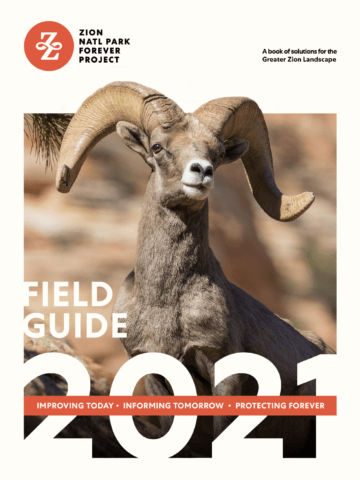2021 Field Guide Released
Highlighting 2020 Accomplishments and Projects For the Coming Year
 The Zion National Park Forever Project announces the release of the 2021 Field Guide. Containing 20 of the park’s most important projects, this guide serves as a book of solutions for some of the biggest challenges facing Zion National Park and Cedar Breaks and Pipe Spring Monuments.
The Zion National Park Forever Project announces the release of the 2021 Field Guide. Containing 20 of the park’s most important projects, this guide serves as a book of solutions for some of the biggest challenges facing Zion National Park and Cedar Breaks and Pipe Spring Monuments.
Released this year in spring, the guide is published with 9 projects fully funded, and with Zion Forever making to date its largest single donation of $3.2 million to support the construction of the new Cedar Breaks National Monument Visitor Contact Station in Iron County. In total, despite the impacts of the pandemic, the Zion Forever Project has already secured more than $400,000 in 2021 towards critical park programs and initiatives. The funded projects span the charity’s three parks, Zion National Park, Cedar Breaks National Monument, and Pipe Spring National Monument.
“Facing one of our country’s most tumultuous years, we are so fortunate to have the Zion National Park Forever Project standing beside us as we continue our mission to conserve and manage these revered lands. As our official non-profit partner, their voice assures that many of our top priorities receive the urgent attention needed, even while negotiating the pandemic’s larger national challenges.” – Jeff Bradybaugh, Superintendent, Zion National Park
This year’s guide also celebrates many noted accomplishments in 2020. Major support from the George S. and Dolores Doré Eccles Foundation coupled with funding from the National Park Foundation and the National Park Service Centennial Challenge Match Grant Program meant that after nearly a decade of closure the Emerald Pools Trail network fully reopened. Accomplishments were not limited to the trails, with Zion Forever Supporters playing a critical role in advocating for a recently awarded $33M grant from the U.S. Department of Transportation to convert the park’s iconic shuttle buses into one of the nation’s first all-electric fleets. The revitalization of the park’s shuttles have inspired a new regional vision with leaders from Kane and Washington County meeting to discuss how a larger sustainable transportation system would revolutionize travel in Southwest Utah. This past season also saw more than 600 acres of land near or adjacent to the park’s borders conserved for their natural and recreational values.
The Field Guide focuses on three interconnected strategic areas: Improving Today, Informing Tomorrow, and Protecting Forever. This season, one of the most important projects involves acquiring conservation easements on approximately 181 acres of land adjacent to the east entrance to Zion National Park, near Mt. Carmel. The securement of the conservation easements and a newly planned visitor center will serve to enhance visitor services and preserve the untrammeled visitor experience within the last unprotected gateway to a National Park in the lower 48 states.
